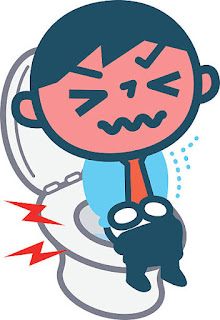The risk factor for the occurrence of hemorrhoids is physical activity, often straining during defecation is the highest risk factor for the occurrence of hemorrhoids (Sunarto, 2016) and is the trigger for hemorrhoids (Rani, Simadibrata, Syam, 2011). As a result, if hemorrhoids are not treated immediately, it will cause complications, namely bleeding that can cause iron deficiency anemia, thrombosis which can cause intense pain, and strangulation of hemorrhoids is a prolapse of hemorrhoids which is then cut by the anal sphincter which can then cause thrombosis (Black & Jane, 2003). 2014).
Generally, grade III and IV hemorrhoids are treated with surgical therapy, namely hemorrhoidectomy, because they usually give good results. However, as a result of the hemorrhoidectomy surgical procedure, excision after surgery will cause severe pain (Shenoy & Anitha, 2014). As in the journal that explains that post-hemorrhoidectomy client pain is a big problem, and needs to get better management (Medina-Gallardo et al., 2017). So pain management becomes a priority after hemorrhoidectomy surgery is performed.
Assessment is the first step in the nursing process. The assessment is carried out aiming to obtain basic data that is used to determine the client's health status, determine actual or potential problems (Debora, 2011).
The main complaint of clients with post hemorrhoidectomy is pain in the anus. Pain can be experienced by clients after hemorrhoidectomy (Shenoy & Anitha, 2014) due to spasm that causes pain in the sphincter and perianal muscles and should be a major consideration. (Smeltzer & Bare, 2013). The signs and symptoms of hemorrhoids usually cause pain and swelling. Fresh red bleeding during defecation (Smeltzer & Bare, 2013) and enlarged hemorrhoids will protrude and cause prolapse (Sjamsuhidajat, 2010).
Because pain is subjective and unique to each individual, a comprehensive pain assessment is needed as a reference in providing appropriate pain management (Zakiyah, 2015). A comprehensive assessment of pain includes five things, namely Provoking or triggers of pain, Quality or quality of pain, Region or location of pain, severity or pain scale, and Time or attack time and frequency of pain (Saputra, 2013).
Nursing diagnosis is a clinical assessment of a health disorder or life process regarding the response of an individual, family, group or community. (NANDA, 2015).
The results of data analysis obtained subjective data; client says pain. Objective data; The client appears to be in pain. Facial expression grimacing in pain. Then a nursing diagnosis was made, namely acute pain related to physical injury agents (surgical procedures) (NANDA, 2015). Acute pain is a sensory or emotional experience that occurs after an acute injury, as a result of a surgical intervention or an illness that lasts a short time or less than six months with pain intensity ranging from mild to severe (Wahyudi & Abdul, 2016). In acute pain nursing problems, several factors can be influenced, namely biological injury agents such as infections, physical injury agents such as burns, surgical procedures, and chemical injury agents such as burns. (NANDA, 2015).
After determining the nursing diagnosis, the next step is to make a nursing plan which is an act of formulating care that is directed at overcoming or reducing the severity of problems that arise and the risk of problems occurring (NANDA, 2015).
Nursing actions that can be taken include; monitor vital signs, do a comprehensive pain assessment, including; location, characteristics, duration, frequency, quality and precipitation factors. Teach pain management using non-pharmacological techniques, teach deep breathing relaxation techniques when pain occurs, teach distraction techniques when pain occurs, do cutaneous stimulation or touch (Bulechek et al., 2013). Instruct the client to choose a comfortable position, and provide cushioning when sitting (Smeltzer & Bare, 2013). Provide information about pain, collaboration with doctors giving analgesics to reduce pain (Bulechek et al., 2013).
Pain management actions using non-pharmacological techniques, namely teaching deep breathing relaxation techniques when pain appears rational; relaxation can relax the muscles that cause pain, teach distraction techniques when pain occurs, rational; distraction will stimulates the descending control system thereby reducing pain stimulation to the brain (Wahyudi & Abdul, 2016). Instruct the client to choose a comfortable position, and provide cushioning when sitting rationally, comfort will relax and can reduce pain (Smeltzer & Bare, 2013)

